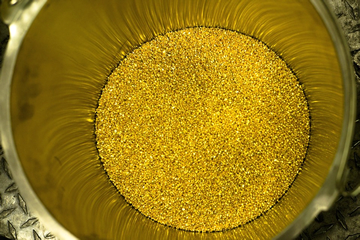Aqua Regia: Drying and Melting Your Gold
Melt and Dry Your Gold
Melting is probably the most satisfying part of refining, because this is the stage when you see your bars of gold. Once you've melted your gold together, the gold will again take on the appearance of metal.
-
Place your beaker on a hot plate and turn it on to dry the gold "mud." Do not preheat the hot plate or thermal shock may cause the beaker to break. Once dry, the gold powder should pour out like sand.
-
Melt your gold powder.
If you're melting using a torch:
-
Wrap your gold powder in tissue paper.
-
Soak this tissue paper, with the gold inside it, in rubbing alcohol.
-
Place your alcohol-soaked gold and tissue paper in a Burno crucible. This will keep your gold from being blown away by the gas pressure from the torch.
-
Melt your gold.
If you're using an electric melting furnace:
Simply pour the gold powder into a clean crucible and melt.
Browse crucibles and melting accessories
You've Got Gold!

Congrats! You've now got gold of at least 99.95%+ purity. You can get even greater purity by refining the same gold again.
That's great, but what about my platinum?
If you had platinum in your gold, it will not dissolve, to any appreciable degree, in the room temperature aqua regia. It will be left behind when you pour off the aqua regia, prior to precipitation.
To ensure high purity of the platinum, you will need to re-refine this material. Repeat the same process, but make these changes instead:
-
Put this material in a fresh aqua regia bath.
-
Heat the acid to simmering. Continue heating until all the platinum is dissolved (that may take 1-2 hours).
-
When completely dissolved at 1 ounce of ammonium chloride for every ounce of dissolved platinum.
-
The platinum will precipitate as a red mud.
-
If you want to leave the iridium in the platinum, then wait for it to precipitate before recovering the platinum.
-
Iridium will precipitate as a blue-black mud after the platinum precipitates.
-
Platinum group metals will also show up on the stannous chloride test.
-
Platinum turns red, palladium.
-
Palladium turns orange and .
-
iridium turn blue-black
-
© 2025 Shor International Corporation & The I. Shor Company. All rights reserved.